Supermicro X11SPM-TPF Performance
For this exercise, we are using our legacy Linux-Bench scripts which help us see cross-platform “least common denominator” results we have been using for years as well as several results from our updated Linux-Bench2 scripts. Starting with our 2nd Generation Intel Xeon Scalable benchmarks, we are adding a number of our workload testing features to the mix as the next evolution of our platform.
At this point, our benchmarking sessions take days to run and we are generating well over a thousand data points. We are also running workloads for software companies that want to see how their software works on the latest hardware. As a result, this is a small sample of the data we are collecting and can share publicly. Our position is always that we are happy to provide some free data but we also have services to let companies run their own workloads in our lab, such as with our DemoEval service. What we do provide is an extremely controlled environment where we know every step is exactly the same and each run is done in a real-world data center, not a test bench.
We are going to show off a few results, and highlight a number of interesting data points in this article.
Python Linux 4.4.2 Kernel Compile Benchmark
This is one of the most requested benchmarks for STH over the past few years. The task was simple, we have a standard configuration file, the Linux 4.4.2 kernel from kernel.org, and make the standard auto-generated configuration utilizing every thread in the system. We are expressing results in terms of compiles per hour to make the results easier to read:
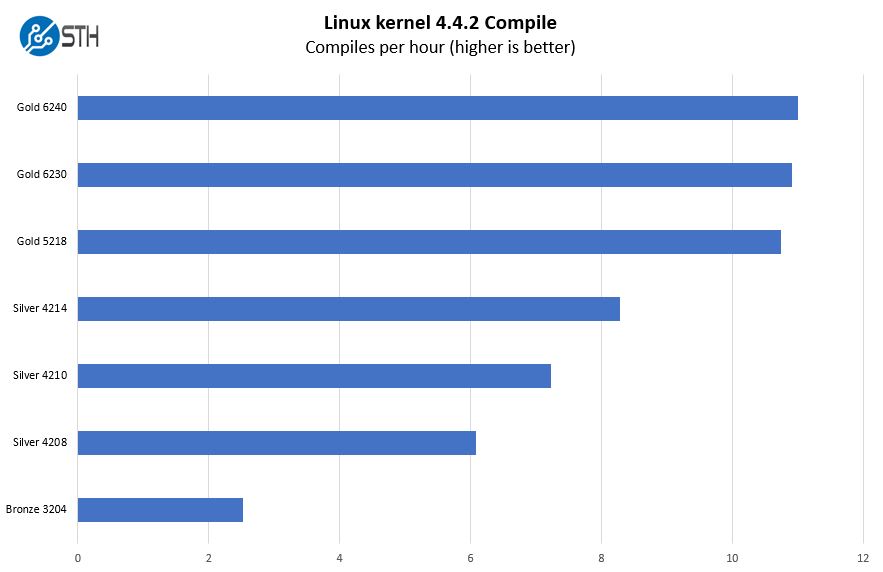
Here we wanted to show a sense of scale in terms of performance. Intel has a wide range of CPU options to choose from. We focused on the Intel Xeon Bronze, Silver, and Gold range to show what we feel are some realistic options.
c-ray 1.1 Performance
We have been using c-ray for our performance testing for years now. It is a ray tracing benchmark that is extremely popular to show differences in processors under multi-threaded workloads. We are going to use our 8K results which work well at this end of the performance spectrum.
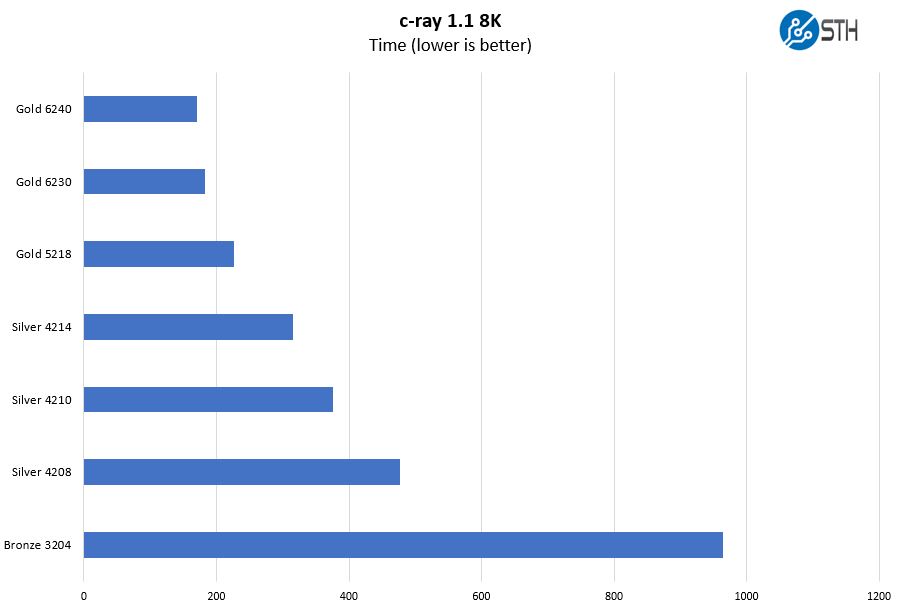
Here we wanted to address one of the big suggestions for the Supermicro X11SPM-TPF. It is a lower-cost platform, but there is an enormous benefit from moving beyond the Intel Xeon Bronze 3204 to the Intel Xeon Silver 4208. The price delta is around $200, but it vastly increases the versatility of the platform.
7-zip Compression Performance
7-zip is a widely used compression/ decompression program that works cross-platform. We started using the program during our early days with Windows testing. It is now part of Linux-Bench.
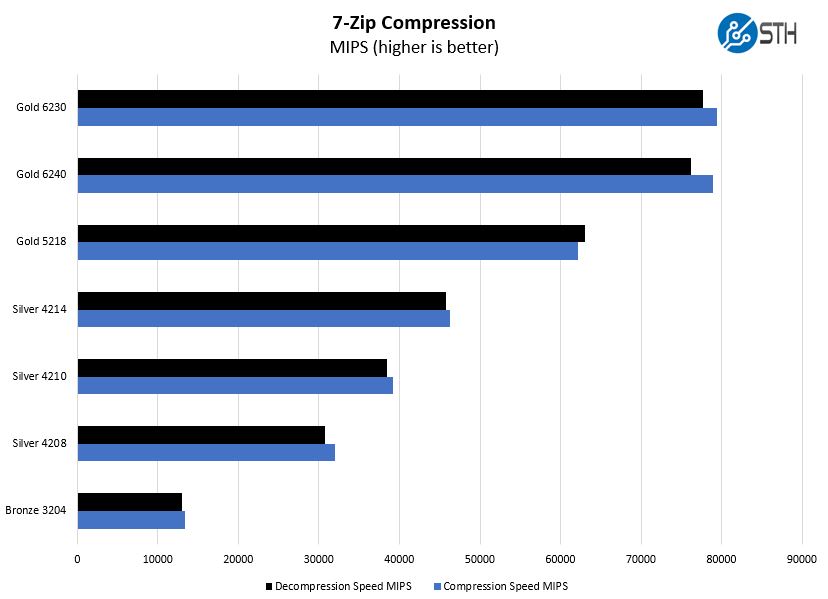
There is also a great benefit to upgrading from that Silver 4208 to the Intel Xeon Silver 4210. You add two cores to the Supermicro X11SPM-TPF for only about $80. We think the Silver 4210 is a sweet spot for the lower-cost platform configurations. Storage servers may not need that much performance, but it adds a lot of flexibility.
OpenSSL Performance
OpenSSL is widely used to secure communications between servers. This is an important protocol in many server stacks. We first look at our sign tests:
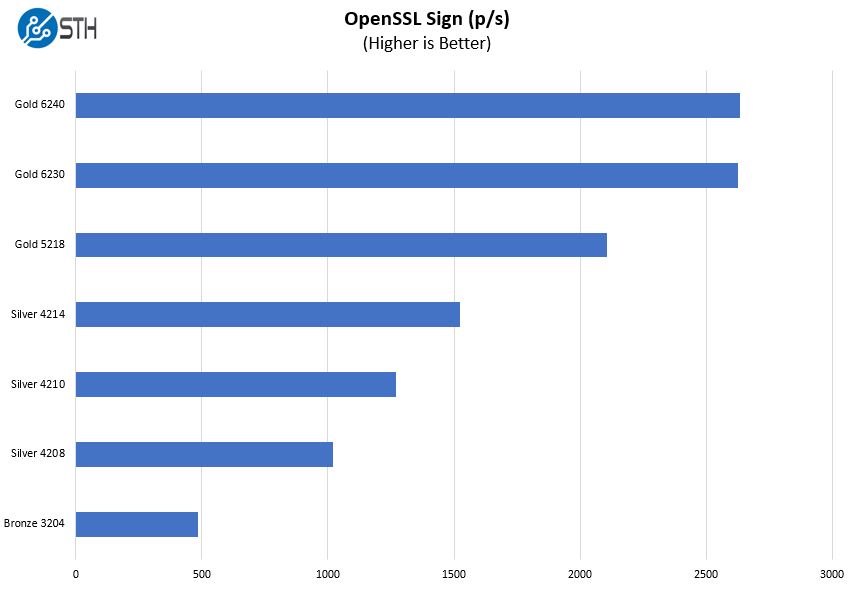
Here are the verify results:
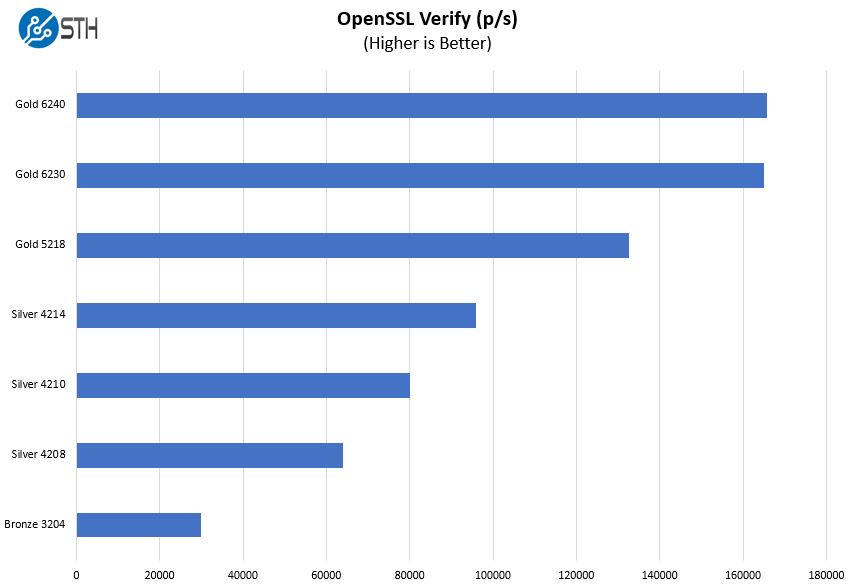
The Supermicro X11SPM-TPF scales up to 165W TDP CPUs. We actually had a Xeon Platinum 8260 working in the motherboard but removed that from our charts since it is not a supported configuration. Still, one can scale to excellent levels of performance with 20-28 cores in this motherboard.
Chess Benchmarking
Chess is an interesting use case since it has almost unlimited complexity. Over the years, we have received a number of requests to bring back chess benchmarking. We have been profiling systems and are ready to start sharing results:

Overall, we simply wanted to show how some of the options we have tested impact potential buyers. This should give some sense of relative performance between different SKUs but Intel has many SKUs available. Check STH for more in-depth looks at the performance of individual parts relative to others.
Next, we are going to look at the topology and then give our final thoughts.



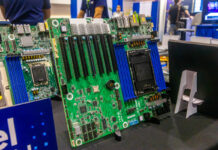
I wonder what percentage of STH reviews get a 9.3 rating. I bet it’s high.
– Ryan
I think STH reviews are pre-informed choices that Patrick knows fit a niche in the first place. Hence, the 9+ reviews ar emany.
In this case if you need a mATX intel cpu mainboard…Tyan? Gigabyte? Asus? Asrack? I think we’d only consider Supermicro or maybe Gigabyte in a server deployments built in house. If an Asus or Asrack were reviewed it might be more interesting but I don’t know it would change my mind.
It’s my impression these reviews are done because STH is running a lab for their own internal deployments and just publishing the results as a sort of side-project-blog. It probably makes them some money for ads and gets them noticed for what they can do, but I don’t think the reviews themselves are the primary “product” of the STH site.
Just some thoughts.
First, Matt I think you are right. If you think about it, there are three primary filters. Servers are so competitive and relatively standardized that a 5/10 or 7/10 product will never come to market. Our team does curate a bit in terms of what we want to review. We do not waste time on silly products. Vendors do not want us to review products that are poorly designed. On the consumer side, there is more market diversity. On the server-side, anything below an 8/10 cannot be sold. Most companies would not want to have the bottom half of their portfolio reviewed as well.
On the lab for internal deployments bit. It actually takes a ton of time/ money/ effort to get these reviews done. For example, with this motherboard, we need multiple CPUs, 6x 32GB DDR4-2933 sticks, SSDs, a chassis, PDU, power meters, network switches and gear, and more. We have a fairly good system for getting reviews done, but it is far from a side project. For some context, we are the largest site that is dedicated to independent data center hardware reviews at this point. By page views, it is not even close. I actually see reviews as central to what we do. Good topic for my Q4 Letter from the Editor.
Ryan – we provide a ton of free data/ views to our readers that is basically unavailable otherwise. If you want more detail, it is there. We are not doing the write 500 words, use all stock photos, and give products an award model. I think the natural selection process probably biases the ratings higher as you gather. Given the three logical filters to us doing a review, it is what you would expect, right?
I have it in config with 4108, 196mb ram , 2 lsi host bus adapters and 16 hdds + m2 ssd for the os. Software raid array .With teamed Ethernets , it saturates 10gbe. File’s filler.
My build, works already 11 months without headache .
on 2nd page:
“Storage HDDs: 4x 10TB Western Digital Red”
is it enough storage? ;P
Patrick, I did not mean my comment to be insulting. I really appreciate what you’ve built here. I am a data scientist, heading up the engineering team at a new R&D center for a multinational consultancy and STH is the only computer hardware site aimed at people like me (I am not a gamer). I look at STH every day. The thing is, when you spend all day thinking about data, metrics, scores, etc, you can’t really turn that off. I noticed what seemed to be a gaussian distribution of scores around 9.3 with low variance at STH and thought I would mention it here because, to me, understanding what scores mean involves looking at how they are distributed. I also thought it was kind of funny. To be honest the scores are not the important part of your work for me, it’s all the technical detail and context about the marketplace. STH is wonderful, thank you for it.
Hi, did you measure the power consumption in watts with a 12 Volt dc adapter under vmware esx 6.7, thanks, stefan?
Hi, I am on the evaluation for my new Home Server, and this practically motherboard will my prefered one. Now, I saw on the supermicro website, that the version -TF and -TPF has the chipset C622 instead of the C621 from the lower spec -F version. That is realated to the compatibility from the OS side. So why I can not put Windows 10 pro on the two 10G LAN versions?
@patrick Thankyou for the great work that STH is doing. I don’t buy any hardware without searching STH first.
I also regularly check in on STH for tech trends & updates.
I almost purchased this Supermicro motherboard MBD-X11SPM-TF (& later the X11SPH-nCTF) the until I saw the ASROCK EPC621D6U-2T.
Asrock seems to have understood the need to reduce the sata cabling from the motherboard to the HDD backplane without the need for hardware RAID.
Will you be reviewing the ASROCK EPC621D6U-2T anytime soon?
Hi Tony. ASRR is a small outfit so getting things done such as reviews is very difficult as there are often no test units available.